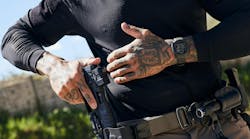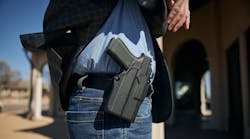Back in January I wrote a review that was essentially a discussion about holsters for field use. In that review I mentioned the BLACKHAWK! Level III SERPA holster system that allows use as a duty holster, cross-draw holster, pancake holster or mounted on a "tactical" thigh platform. For about two years now I've been bugging BLACKHAWK! for a SERPA Level III holtser for my Springfield Armory 1911 .45ACP. Yes, I know: it's big, it's heavy and it only holds nine rounds (8+1). But I started my law enforcement career carrying a Government Model 1911 .45ACP in Uncle Same's Army and I've never lost my fondness for it. I'm competent and confident with it and I just wanted a good-coverage secure holster to carry it in. BLACKHAWK! came through.
The heart of the SERPA design is the trigger guard security device that is spring loaded to latch onto the weapon's trigger guard when it is holstered. In the top cutaway photo you can see SERPA lock and release mechanism in detail. Note that this cutaway was rendered using one of the SERPA CQC (concealed) holster designs - not a duty holster which has a thicker body and greater coverage for the weapon.
Thanks to the design thoughtfulness of the team at BLACKHAWK!, the duty holster bodies can be mounted on either a belt platform, the shown tactical platform, a quick-release platform or a MOLLE / STRIKE platform. If you really wanted to, you could even put the duty holster body onto the pancake platform, but why would you?
When I received the holster for testing my first thought was, Can I carry my 1911 both cocked-and-locked OR hammer at half cock OR hammer down? It was easy enough to test and the photos show plastic 1911s holstered both cocked-and-locked and hammer down. Holstering with half-cock (although I can think of no reason why anyone would intentionally do this) can also be done as I tested with my unloaded 1911.
The three levels of retention that are built into this holster design are:
- Tension: If you look at the holster body, just below where the trigger guard would end on the pistol, you'll see a philips head screw. That screw can be tightened or loosened to adjust how much tension the holster applies to the weapon. Bear in mind that, as with all tension adjustable holsters, the tension is mostly applied to the trigger guard and dust cover.
- SERPA Locking mechanism: As shwon in the cutaway diagram, the SERPA lock is a spring loaded lug on a pivot that latches onto the trigger guard when the weapon is fully holstered. To release the lock you press appropriately on the proper end of the lever. Upon drawing, if you keep your index finger positioned properly, it will be indexed along the weapon's frame as you complete the draw stroke.
- Pivot Guard: The spring-loaded hinged pivot guard is released by your thumb automatically as you secure a proper grip on your weapon prior to unlocking the SERPA lock. Upon release the pivot guard springs forward clear and out of the way and current models of the holster prevent the pivot guard from being accidentally closed by bumping or in a scuffle. To close the pivot guard you have to push in the release lever and hold it in while you push the pivot guard up and closed. Holding the pivot guard in place you release the lever and the spring system locks the pivot guard shut.
So, to draw a weapon from this holster you simply secure your grip as you would normally - your thumb releasing the hood. With your index finger you press on the SERPA release, which takes very little effort and can be done quickly with just a few practice draws (using a training "dummy" gun or an unloaded and safe weapon). Then you complete the draw stroke with your weapon in a secure grip and your trigger finger properly indexed along the frame / bottom edge of the weapon's slide.
As I did all that I wondered, If the weapon is cocked-and-locked and the SERPA lock released, can it be drawn with the hood closed? Yes, I know it seems a silly question, but there's enough room under the hood for the weapon to be carried hammer down and the 1911 is a relatively thin weapon compared to some modern day double-stack pistols. I had to test it out. Using the BLACKHAWK! training weapon I had at hand (the gray colored 1911 cocked-and-locked) I released the SERPA lock and tried to wiggle the gun out of the holster with the hood still locked shut. Try as I might, I couldn't get the gun out. In the end, I was satisfied that the design was properly balanced to keep a cocked-and-locked pistol in.
I did all that before I even took the holster off the duty-belt mount. Three screws secure it onto the duty-belt mount and four are used to secure it onto the "tactical" platform as shown in the photos. Switching it out took me about three minutes and the Glock holster I took off the thigh platform is now securely mounted to the duty-belt platform.
Shown on the BLACKHAWK! website with a suggested retail price of $102.99, a quick Google search found several dealers that have these holsters as low as $70. I've yet to be able to break one and with just a little training they are amazingly fast to draw from.
Stay safe!



